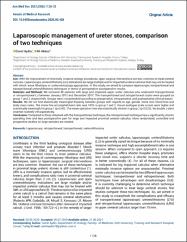| dc.contributor.author | Aydın, Cemil | |
| dc.contributor.author | Akkoç, Ali | |
| dc.date.accessioned | 2022-11-30T05:46:16Z | |
| dc.date.available | 2022-11-30T05:46:16Z | |
| dc.date.issued | 2021 | en_US |
| dc.identifier.uri | https://search.trdizin.gov.tr/yayin/detay/463570/laparoscopic-management-of-ureter-stones-comparisonof-two-techniques | |
| dc.identifier.uri | https://hdl.handle.net/20.500.12868/2068 | |
| dc.description.abstract | Aim: With the improvement of minimally invasive urology procedures, open surgical interventions are less common to treat ureteralcalculus. Laparoscopic ureterolithotomy (LU) indications are large multiple and/or impacted ureteral calculus that may not be treatedwith shock-wave lithotripsy or ureterorenoscopy approaches. In this study, we aimed to compare laparoscopic retroperitoneal andtransperitoneal ureterolithotomy techniques in terms of perioperative-postoperative results. Materials and Methods: We reviewed 45 patients with large and impacted upper ureter calculus who underwent transperitonealor retroperitoneal LU between January 2012 and December 2017. The transperitoneal and retroperitoneal routes were grouped asgroup 1 and 2, respectively. Groups were crosschecked according to preoperative, intraoperative, and postoperative clinical datum. Results: We did not find statistically meaningful disparity between groups with regards to age, gender, stone size, blood loss andbody mass index. The stone free accomplishment ratio was 100% in group 1 and 2. Visual analogue scale scores were higher andstatistically meaningful in group 1 (p<0.05). The mean operative time was statistically shorter in group 2 (p:0.022). No double J stentinserted routinely intraoperatively. Conclusion: Compared to those obtained with the transperitoneal technique, the retroperitoneal technique has a significantly shorteroperating time and less postoperative pain for large and impacted proximal ureteral calculus. More randomized, controlled andprospective studies on large samples are needed. | en_US |
| dc.language.iso | tur | en_US |
| dc.relation.isversionof | 10.5455/annalsmedres.2020.05.428 | en_US |
| dc.rights | info:eu-repo/semantics/openAccess | en_US |
| dc.subject | Laparoscopy | en_US |
| dc.subject | Retroperitoneal | en_US |
| dc.subject | Transperitoneal | en_US |
| dc.subject | Ureterolithotomy | en_US |
| dc.title | Laparoscopic management of ureter stones, comparisonof two techniques | en_US |
| dc.type | article | en_US |
| dc.contributor.department | ALKÜ, Fakülteler, Tıp Fakültesi, Cerrahi Tıp Bilimleri Bölümü | en_US |
| dc.identifier.volume | 28 | en_US |
| dc.identifier.issue | 6 | en_US |
| dc.identifier.startpage | 1128 | en_US |
| dc.identifier.endpage | 1133 | en_US |
| dc.relation.journal | Annals of Medical Research | en_US |
| dc.relation.publicationcategory | Makale - Uluslararası Hakemli Dergi - Kurum Öğretim Elemanı | en_US |


















